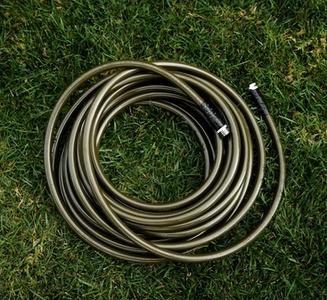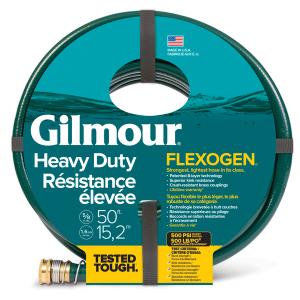The best time to fertilize your lawn
Quick answer: Apply lawn fertilizer in the early morning or evening when temperatures are between 50-69°F.
- For Northern lawns, fertilize in spring and fall.
- For Southern lawns, fertilize in spring and summer.
Always apply to a damp (not wet) lawn, look for 3 rain-free hours before application, and never fertilize during drought or high heat when temperatures exceed 85°F.
Reapply every 4-6 weeks during the growing season as conditions allow.
Sunday Tip:
New to lawn care? Visit our beginner's guide to lawn care.
Want a custom lawn care schedule for your exact location? Let us do the timing math for you with a custom lawn plan.
Fertilize based on your region
Northern lawns need different care than Southern lawns. Here's what you need to know about each:
Northern lawns (or cool-season grasses)
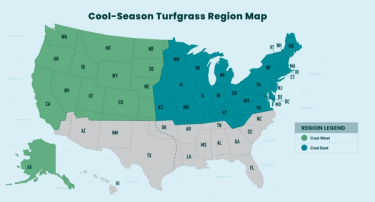
These grasses thrive in the Northeast, Midwest, and Pacific Northwest. They include grass types like Kentucky Bluegrass, fescues, and perennial ryegrass.
When to fertilize cool-season grasses:
- Spring and fall are prime feeding seasons
- Start when temperatures hit 50-59°F
- Focus on March-May and September-October
Sunday Tip:
Southern lawns (or warm-season grasses)
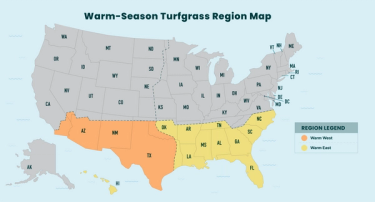
Found in the Southeast, Southwest, and Gulf Coast. Common types include Bermudagrass, St. Augustine grass, and Zoysiagrass.
When to fertilize:
- Spring and summer are key feeding times
- Begin when temperatures reach 60-69°F
- Focus on April-August
Sunday Tip:
Things to know before applying lawn fertilizer
Check these conditions first:
- Your lawn should be hydrated but not wet
- Mow the lawn before applying (psst. learn proper mowing heights)
- Make sure the grass isn't stressed from drought
- Avoid temperatures above 85°F
When to avoid fertilizing
Press pause on fertilizing your lawn if you see:
- Rain clouds gathering (you need 3 rain-free hours post-application!)
- High heat warnings or temperatures above 85°F
- Drought stress
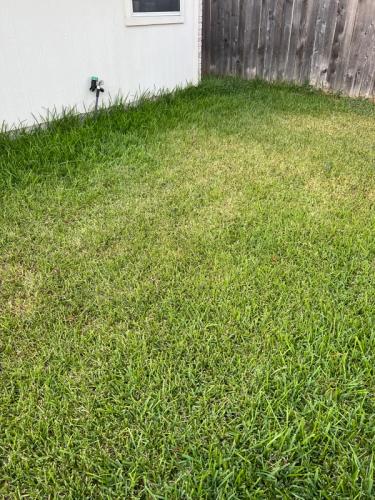
Know your fertilizer blackout dates
Do you live in Florida, New York, Maryland, Vermont, or New Jersey? You might have seasonal state-wide or county restrictions on fertilizer.
While Sunday fertilizers do not contain phosphorus and may not fall under the restriction, it's always good to know when and what your local fertilizer blackout restrictions are before you apply!
Plan your next fertilizer application
For best results, plan to fertilize your lawns every 4-6 weeks during your grass type's growing season and optimal conditions.
Watch for these signs that your lawn is ready for another application:
- Growth has slowed
- Color is slightly fading
- You're still mowing regularly
Sunday Tip:
Take a photo after fertilizing to track your lawn's progress and know when it needs the next application.
Sunday lawn care calendar
Your fertilizer schedule works best when it's part of a complete lawn care routine. Just like fertilizing, activities like mowing, watering, and weed control all have their perfect moments throughout the year.
Sunday Tip:
Want exact timing for your lawn? Get a custom schedule with your Sunday lawn plan.
How to use our lawn care calendars
Our seasonal calendars show when different lawn care activities can be done throughout the year. Most lawns only need some of these. So, think of them as a menu of options, not a to-do list!
Here's what you need to know:
- Check marks show optimal timing windows, not required tasks. Many tasks (like dethatching or aerating) aren't needed annually or ever!
- Time soil care (like aeration) about 2-4 weeks before seeding.
- Grub control is more effective in spring and fall when grubs are feeding
- Some products have regional restrictions (like Dandelion Doom in CA)
Sunday Cool-season Lawn Calendar
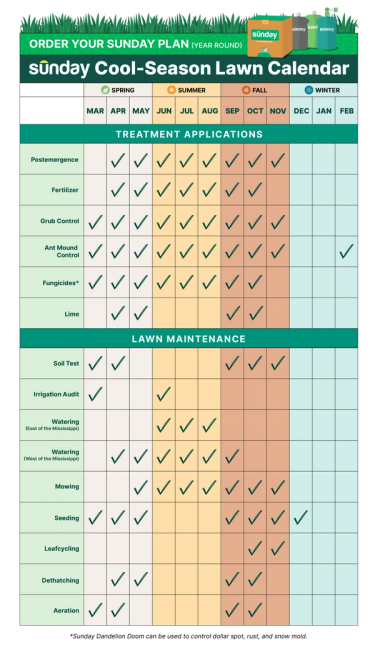
Sunday Warm-season Lawn Calendar
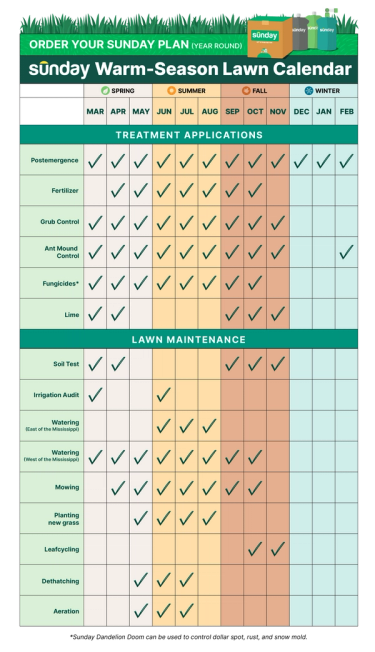
More Sunday lawn care guides
- How to Apply Sunday in One Weekend
- The Ultimate Lawn Care Calendar
- How to Use Leftover Sunday Pouches
- Sunday Liquid vs Granular Lawn Fertilizer
- Year Over Year Benefits of Sunday
- Environmental Benefits of Lawns (and How to Grow an Eco Lawn)
- Sunday Lawn Report
- 7 Misconceptions About Lawn Care
Let's get growing
Our lawn engine uses satellite data to map out your lawn size and determine things like average rainfall, common weeds, and pest activity.












